|
The Creation Curse Catastrophe Model of Robert Gentet
by Barry Setterfield, March 2017.
We received an email asking about Robert Gentet's geological model. Here is Barry's response.
Around the year 2000, after a wait of about five years, a paper of Robert E. Gentet’s was published in CRSQ Vol 37: 10-21. In this paper Gentet presented a new geological model based creation, the curse, and the catastrophe of the Flood. Since all those words begin with a “C” his model is referred to as the CCC Model. This first paper received two published responses. The first was by Michaell Oard in CRSQ Vol. 40:58 and the second by Jerry Akridge in Vol. 40:65. Gentet responded to those two in Vol. 40, page 141. In 2007, Gentet published an updated version of his model.
Overview of Gentet’s CCC Model
The CCC Model presents the entire Pre-Cambrian series of strata as having been laid down in the period from Creation to the Fall, when the Curse on the land was pronounced. All strata above this – the entire Paleozoic, Mesozoic and Cenozoic – are considered to occur simultaneously, with Flood strata in different places depending on where in the world one is. What is presented is that the various sections of strata record the spread of life-forms in specific ecosystems and interlinked food chains after the Curse. It is suggested that the Curse manifested as a large number of individual disastrous events and the geologic record represents the growth prior to and recovery from those events as life-forms proliferated and spread. Thus the Paleozoic Era deposits represent the effect of these events on life-forms in ocean and/or shallow water/swamp environments. The food-chain here consisted mainly of algae, mosses and ferns and the creatures which lived on them and loved water. The Mesozoic represents the ecological environments on land near river estuaries or large inland lakes where palms, pines and ecologically related plants dominated. This provided the basic food for the dinosaurs and associated fauna. Finally, the Cenozoic Era strata represents those environments where the spread of mankind, mammals and angiosperm plants across the earth is recorded. On the CCC model the Cenozoic Era is considered to represent mankind’s environment from the time of Eden until now. This, and the other initial ecocentres started small and grew as the various food chains and populations expanded. In other words, it is envisioned that all three Eras were running more or less concurrently, and some grew to overwhelm the others. Unlike the standard Creationist model, the Gentet CCC model does not consider the Flood to have resulted in the major part of the fossil record. Neither does it close any or all of the three Eras. Rather, it is claimed that the position of Flood strata must be determined by local geology. This allows for some strata to be post-Flood in each of the three Eras.
Some Problems with the CCC Model
Both the geological data and Biblical considerations pose problems for this model. Here are some of them:
1. The rock record is a vertical sequence. All over the world, the Cenozoic is over the Mesozoic and both are over the Paleozoic series of strata. This does not vary. This can be seen in the complete geologic columns that can be found in the Williston Basin in North America, the Bonaparte Gulf Basin in Australia and elsewhere around the earth where the vertical stacking is obvious. In no place in the world do the major eras exist as the horizontal co-existing systems that the CCC Model envisages. (This basic flaw applies in every model where creationists support ecological zoning explanations of the fossil record.)
There are, in fact, a number of areas of the world where the idea of the strata representing ecological zoning all existing contemporaneously is shown to be totally false. One such area is in Spain. In Spain there are a series of coal measures on top of which is a fossilized sponge reef. The sponge fossils were clearly not washed in, as they are vase-shaped sponges which grew in place. They are complete and the large tops are still in place on the smaller bases. They were buried growing there. Had they been washed in over the coal beds, they would have been broken up and the heavier tops under the lighter bottoms. This means the coal had to be covered with water before the sponges could grow.
Then, on top of the fossilized sponges, there are a number of layers of dinosaur nests. Dinosaurs laid their eggs on land, not on sponge reefs. These three different eco-systems are stratigraphically on top of each other in a plain vertical time-sequence of events. Similar illustrations, where Paleozoic strata lie beneath Mesozoic layers which lie beneath Cenozoic fossils and ecosystems, abound world-wide and negate the proposition of horizontally expanding ecosystems. On this point alone, the CCC Model is shown by the data to be invalid.
2. Between the Paleozoic and the Mesozoic strata, around the world, is a layer of volcanic ash beds, shocked quartz and some iridium anomalies. After this point, about 95% of the fossilized marine life forms are never seen again. Further evidence that this was a catastrophic event is in the evidence of the changing carbon ratio found in the fossil record. There was a dramatic change in the carbon 12 to carbon 13 ratio at that point. This would result from an awful lot of volcanism, extruding carbon from under the crust. Ash from wildfires would also contribute to this. This layer is referred to as the Permian Extinction Event.
We have a similar layer between the Mesozoic and Cenozoic series of strata, often called the K/T Extinction Event. Again, we have ash layers, shocked quartz, and anomalous iridium. Again we find evidence of a massive extinction, where a very large percentage of life forms are never seen again either in the fossil record or in our known history.
Neither of these catastrophic records are associated with a flood. Both are associated with impact events. If they leave such clear records in the geologic column, the Flood certainly should have left a similar or even more extensive record. Instead, the CCC model presents the idea that the record of the Flood which the Bible says destroyed the entire earth can be found only as localized evidences in different areas of the world. Not only does the Bible disagree with this, but the vast number of localized catastrophes to produce the geologic record that we have makes the CCC model untenable. Photographs follow below.
3. The strata in each Era follows the same pattern worldwide. That is to say, for example, that banded iron formations are common in the Pre-Cambrian; purple and white quartzites are found around the world in the lower Paleozoic; red sandstones and limestones are common in the Mesozoic. It may be argued that these are products of the environment and so would be expected. However, there is another component to this. The cementing material making up the rock has often been extruded from the interior of the earth as a solution by one process or another. At any one time, these processes were extruding solutions of similar composition world-wide. Thus, there were iron-rich solutions being outpoured from the earth interior in the Pre-Cambrian; silica-rich solutions in the Paleozoic and carbonate rich solutions in the Mesozoic. These solutions were outpoured on a world-wide scale. It is inconceivable that these outpourings from the interior were related to surface ecology.
4. Radiometric dating is based on the length of the half-lives of various heavy elements. The more daughter elements are found within a sample in relation to the mother elements, the older the sample is. For the sake of argument, it does not matter how many years are involved, but only that relative ages are apparent this way. In the geologic column, the lower one goes in the strata, the older the dates become. This alone denies the idea that the various major eras were contemporaneous.
If they really were contemporaneous, then the same dating methods should show similar dates throughout the various strata. That does not happen. Invariably the Paleozoic dates older than the Mesozoic, both of which date older then the Cenozoic.
5. The final point concerns a Biblical matter. It is apparent to most readers that Genesis 1:29-30 indicates that both man and all animals were vegetarian at the time of Creation. It is then often assumed that a change in diet occurred at the time of the Fall when the Curse was pronounced. However, while this idea may be common, it is, nonetheless, only an assumption and does not have Scriptural warrant. Indeed, when Genesis 1:29-30 is compared with Genesis 6:21 and then Genesis 9:3-5, it indicates that the change in man’s diet as well as that of animals (“every beast” in Gen. 9:5) occurred after the Flood event had ended and a new world with an entirely different ecology had begun. The Flood process had destroyed many the previous food sources, and the restricted choices available necessitated meat to be included. Therefore, Scripturally, meat eating was only introduced after the Flood had ended. This meant that animals did not eat each other prior to the Flood.
This is an important point. Throughout the Paleozoic, Mesozoic and Cenozoic there is abundant fossil evidence of animals eating one another. Scripturally, then, these three Eras must come after the Flood -- after meat was included in the diet, not before. That means that the latest that the Flood layers can occur is just before the “Cambrian Explosion.”
Do we have any actual worldwide evidence of a Flood before the Cambrian? Yes, and it is quite dramatic. It is interesting that scientists agree that internal heating caused both Venus and Mars to flood. They are planets on either side of us in the solar system. However a Flood on earth? Too close to the Bible, so it must be discarded. As a result, they view a thousand-foot-thick layer of diamictite as being evidence of worldwide glaciation, under the presupposition that only glaciers could carry boulders over 300 miles and then cement them into a lmestone. The first problem with this explanation is that the limestone matrix is of a variety that can only form in warm to hot water. The second problem with this “Snowball Earth” explanation is that on top of this thousand foot later lie two miles of finely laminated shales and slates, black with carbon and kerogen. Kerogen is the result of the deterioration of flesh and muscle tissue.
If this is indeed the Flood strata, then, contrary to many creationist models, the Flood did not produce any fossilization at all. It was too massive and too destructive. The waters exploding from under the crust were scalding, as remembered in many legends around the world. Thus the fossils in the Paleozoic, Mesozoic and Cenozoic must all be post-Flood, and result from an earth shifting and sliding after each catastrophe as it regained stability.
In conclusion, Gentet’s model defies both geology and the Bible. There is no way geologically the eras were contemporaneous; there is strong evidence of worldwide catastrophes separating the eras; and radiometric dates are increasingly older the deeper into the crust we go. Biblically we read that the world of that time was completely and totally destroyed and that even the trees of Eden are now deep within the earth. The geologic column is real and the Flood was massive.
 |
Ash layer marking Permian extinction event in coal measures from the Sydney Basin, New South Wales, Australia. The same strata in New South Wales is below. |
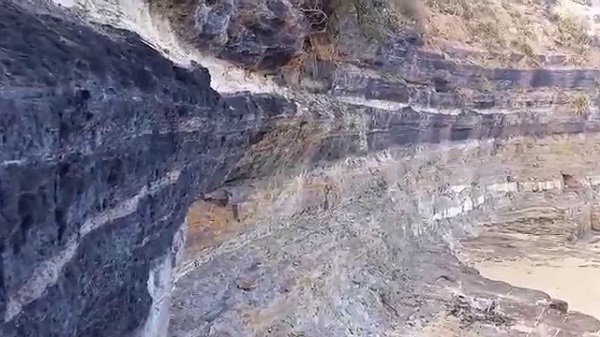
Below is the Permian Extinction layer in Guizhou, South-East China.
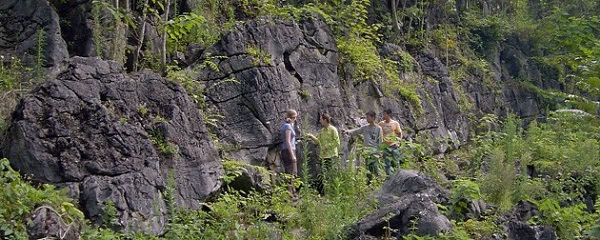
Below: Permian Extinction volcanic ash layer shown by the marker - Karoo Basin, southern South Africa
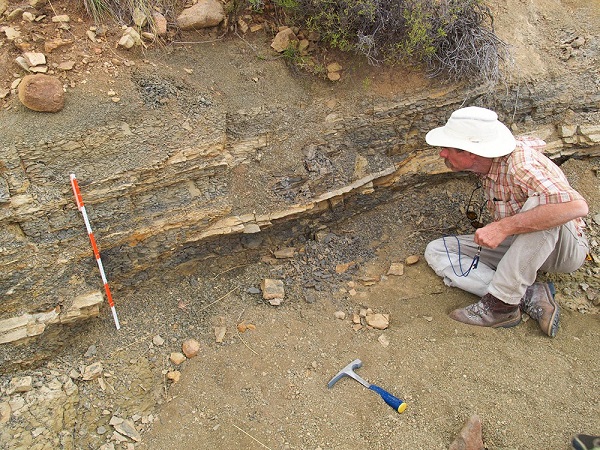
Moving up in the geologic column we find the evidence of the K/T Extinction layer. Below is the ash layer containing iridium from asteroids bordering the I25 in Raton Pass, Colorado

Below: The K/T extinction layers from Mexico where the tsunami from the Yucatan impact also left a layer.
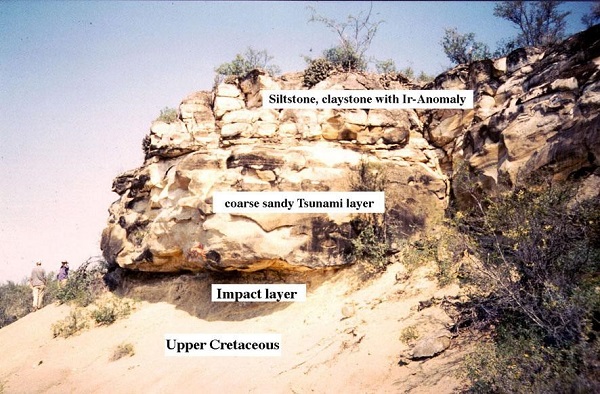
Below: K/T boundary near Jordan, Montana with iridium anomaly and shocked quartz layers and ash. The catastrophe layers are above the dotted line.
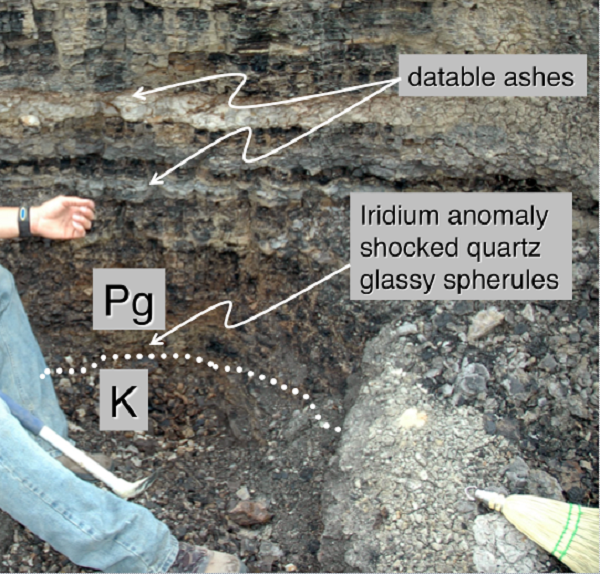
Below: Shocked Quartz grain – lines or striations and color bands in crystal structure come from high pressures and temperatures associated with impact events. This grain was found in K/T boundary clay in Teapot Dome Wyoming.

|







